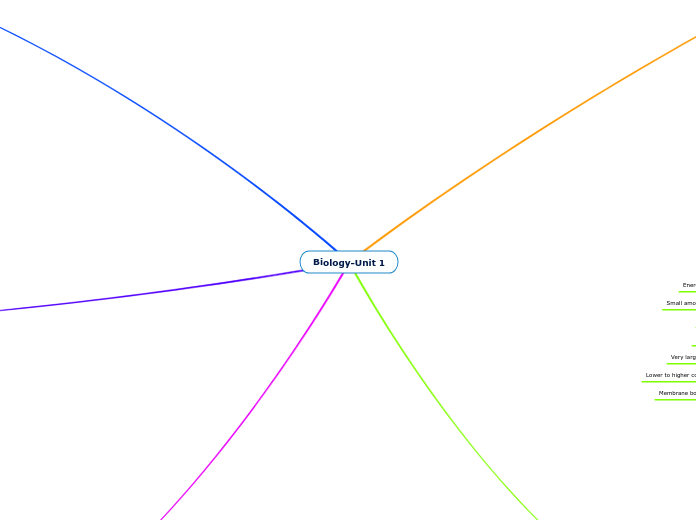Biology-Unit 1
Cell Theroy
Micro Biology
Small molecules
Bacteria/viruses
The study of microscopic organisms
Eukayotes
Uncellular
Has a Nuclues
Has organelles
Cellular
1.All living things are composed to one or more cells
2.The cell is the basic unit of structure and organization in organisms.
3.All cells come from preexisting cells.
Macro Biology
Large molecules
The study of living things seen through the human eye
Prokaryotes
Has no Nuclues
No to few Organelles
Bacteria/ Viruses
Cellular/Uncellular
Macro Moleclues
Amino Acids
Centeral carbon bondes with four atoms to form Amino Acids
peptide bonds
Complex Carbs
Polysaccirides
Glycogen- In humans
Starch- in plants
Polymers
Several Hundered to several thousand monosaccarides
Lipids
Steriods
Phospholipids
Triglycerides
Organic componds
Subtopic
Estentail Waters
Water is a Polar Moleclue
Water is esstentail to life
Water is a reactent
Hydrophobic
Hydrophillic
Nuclec Acids
RNA
DNA
Carbohydrates
Trisaccahrides
Disaccharides
Monosaccharides
Protines
Controls what exits and enters the cells in the membrane
Carries oxygen in blood
Enzymes
Enzymes Inhibator
Protines have the most jobs in a cell
Energy in the cell
Photosynsis
Light energy
Glocuse
Uses glocuse fot cellulair resperation
Plants make more oxygen then what they use
Fermantation
Alcholic Fermentation
Pyrvate is converted to
Ethonal
Carbon dixide
Lactic fermentation
Pryuvate forms lactic acid
Human Muscle cells
Produces fewer ATP cells per glocuse molecule
Cellulair Aerobatic Resperation
Glycosis
Oxidative resperation
ATP
Glocuse molecule= 36 ATP
6 oxygen consumed
6 carbon dixiodied produced
6 waters produced
made of Adenosine and phostpate
ADP
Andonesion dephospite
Chemecial recation that makes a burst of energy
nucleotide
Cell Transport
Passive transport
Simple Diffusion
No Energy
Higher concentration to low Concentration
Small Lipids
Small Molecules
Facilitated Diffusion
No Energy
Ions
Higher to lower concentration
Large Molecules
Membrane Bound protine
Osmosis
No Energy
Water
Higher to lower concentration
Active Transport
Bulk Transport
Energy Required
Small amount of fluids
Exocytosis
Endocytosis
Very large molecules
Lower to higher concentration
Membrane bound protine
Active Transport
Energy Required
Membrane bound Protine
Low to high concentration
Cells/Organelles
Plant Cells
Cell Wall
Chloroplast
Organells in Plant/Animal cells
Nuclues
Vacoules
Cell Membrane
Golgi Apperatus
Smooth ER
Cytoskelenton
Vesiles
Cytoplasm
Ribosomes
Rough ER
Mitocondria
Animal cells
lysosomes
Chentorlie
